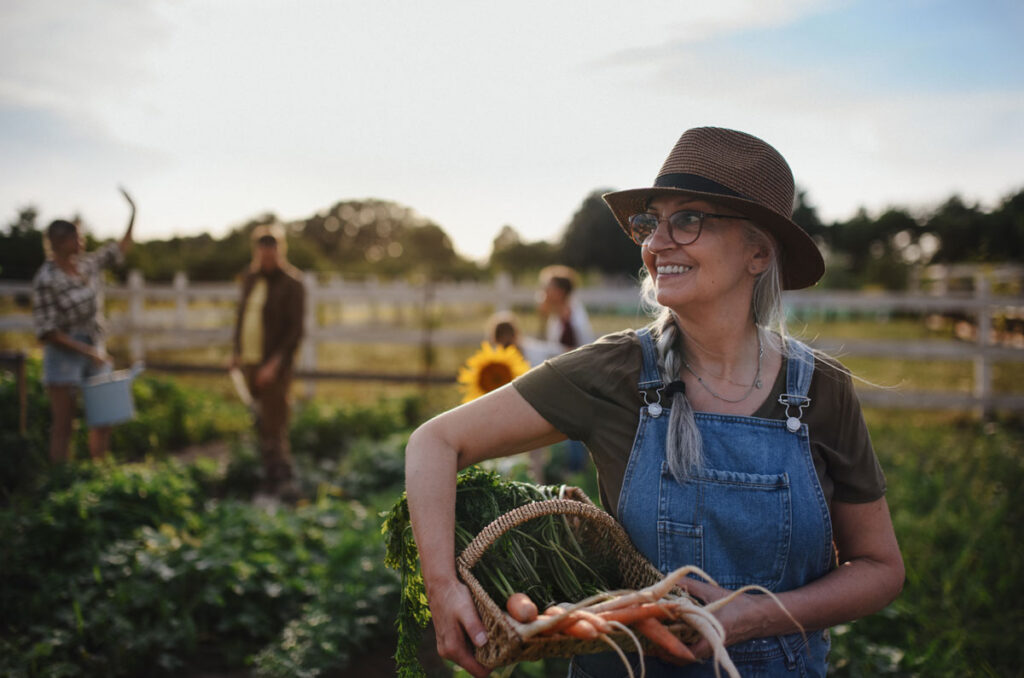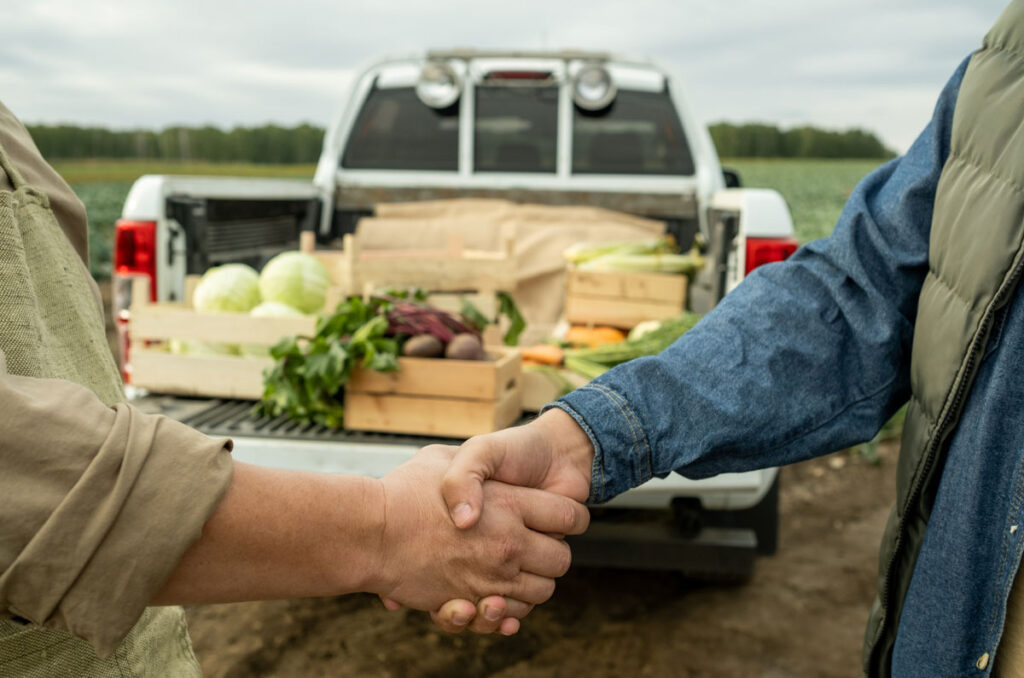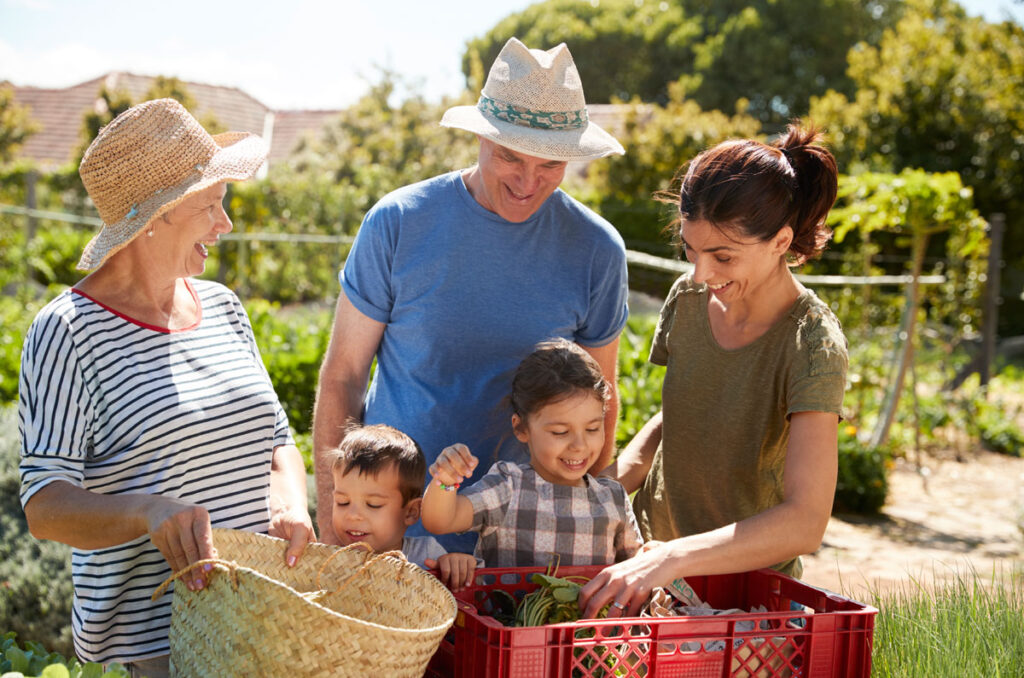You’ve dreamed of breaking free – of escaping the rat race of modern society and forging your own path. Homesteading calls to you as a way of finding that freedom, seeking to create and not consume, living by the work of your own two hands. This do-it-yourself attitude and yearning for independence has drawn you to homesteading, just like it did for me and my husband.
However, as you pursue this dream of self-sufficiency, you might find yourself at risk of isolation. You’ve probably heard stories of homesteaders retreating to remote off-grid locations or becoming so engrossed in their own land that they lose touch with the world around them. While these extreme approaches might appeal to a select few, they overlook one of our basic human needs: connection and community.
The truth is, you don’t have to choose between self-reliance and social connection. In fact, building a strong community can actually enhance your homesteading journey.

In this post, you’ll discover eight compelling reasons why staying connected with other homesteaders isn’t just important – it’s essential for your success and fulfillment.
Are you ready to learn how you can balance independence with the support of a homesteading community? Let’s get started!
8 reasons why building community is an important part of homesteading.
By working together and supporting one another, homesteaders can create thriving communities that help everyone achieve their goals of sustainability, resilience, personal fulfillment – and yes, even contribute to their self-reliance! Let’s explore these eight benefits of homestead community.
Shared Knowledge and Support

With a wide range of skills and knowledge needed to manage a homestead, your community can be invaluable, especially at the beginning of your journey. Just look at the wide variety of homesteaders sharing their lifestyle on social media. They teach and inspire through a variety of social sharing platforms.
Many homesteaders also homeschool their children. These collaborative educational communities provide unique benefits to homesteading kids. They not only receive a well-rounded education, but also develop practical skills, strong community ties, and a deeper connection to their environment.
By building community with other homesteaders, you can share tips, techniques, and best-practices. Your community can assist your family’s growth and build lasting relationships. You’ll learn from others mistakes, and be there for each other with support and friendship.
Access to Resources
Homesteading sometimes requires special tools, equipment, or resources that can be expensive or difficult to find. When we first moved onto our homestead, we had just purchased a tractor, but didn’t have a tiller or disc to work the ground. One of our neighbors offered to till a spot of land in our garden so we could begin planting. In return, my husband used our brush cutter to mow his ditch bank for him.
Within a community, you have opportunities for barter, trade, or collaborative purchasing. This network of shared resources not only reduces individual costs, but creates a spirit of mutual support and provides greater financial resilience.

Food Security

One of the key reasons people have turned to homesteading is food security. While growing your own garden first comes to mind, here are some other ways that you can work with other homesteaders to increase your shared community food resilience.
- Community Supported Agriculture (CSA)
- Seed saving and exchanges
- Shared storage facilities
- Collective food preservation
- Cooperative buying
- Group food preservation
- Skill Sharing
- Community markets
- Collaborative livestock management
- Food foraging groups and classes
Emotional Support and Camaraderie
Homesteading can be challenging, and sometimes isolating. Your frustrations can build when there are setbacks such as garden failures, livestock illness, or overwhelm.
For example, when I first started homesteading in Florida, it was a totally different climate and growing season for gardening than the Midwest where I first learned to grow food. Rather than struggle alone, I reached out to my gardening neighbors, and local online homesteaders. They gave me plenty of great advice and resources to help me learn how to grow in this challenging climate.
As I’ve experienced, being part of a supportive community will give you emotional encouragement, a sense of belonging, and the reassurance that you’re not alone in your struggles.
Networking and Collaboration
Often, you may need extra hands or someone with specialized skills to help you with a homesteading project. The iconic Amish barn-building comes to mind as the perfect example of community collaboration. The entire community will come together and often complete a whole barn in just one day.
By building strong relationships with others, you create a network of individuals willing to collaborate on projects, share workloads, and help when needed.
Preserving Traditions and Cultural Heritage

Homesteading is a practice rooted in generations of wisdom and cultural traditions. Many of my own homesteading practices are rooted in the past – from fermenting homemade sauerkraut to raising chickens, I’ve learned from generations before me.
By building a diverse community, your life will be enriched as you learn from elders, preserve timeless traditions, and then pass them on to the next generation, ensuring that valuable knowledge isn’t lost.
Environmental and Social Impact
Homesteading practices such as organic gardening, renewable energy, seed-sharing, and creating graywater systems, promote environmental care and sustainable living. By engaging in these types of activities, homesteading communities share in their contribution to the ecological health of our world.
Permaculture guilds, seed-saving networks, CSAs, and eco-villages are just a few types of communities that you can seek out to provide you with support and resources.
By being part of a community of like-minded people such as these, you can help create a positive environmental impact and inspire others.
Emergency Support
In times of crisis such as weather-related damage or economic stressors, homesteading communities will pull together. For example, during the Dust Bowl of the 1930s, families shared resources and helped rebuild after damage from devastating storms.
Today, you can create a supportive community that prepares for emergencies by:
- Keeping communications open for sharing information, updates, or requests for help.
- Meeting regularly with other to build relationships and discuss plans.
- Creating a community emergency plan.
- Working with preppers to focus on your common goals of emergency preparedness.
By having a network of individuals you can rely on when times get tough, you can increase your homesteading community’s ability to withstand and recover from emergencies.
Conclusion
I hope this list has inspired you to seek out and grow your own homesteading community. By working together and supporting one another, we homesteaders can create thriving communities that help everyone achieve their goals of sustainability, resilience, and personal fulfillment.
Once you begin interacting with your homesteading community, you’ll discover even more reasons to appreciate and enjoy the camaraderie and connection with other like-minded folks. Their support, friendship, and shared experiences will greatly enrich your homesteading journey.
Happy homesteading!
[…] makes the journey easier, more enjoyable, and far more sustainable. Previously, I wrote about the 8 Benefits of Building a Strong Homesteading Community and why it’s so important. But today, I want to take it a step further and look at how we can […]